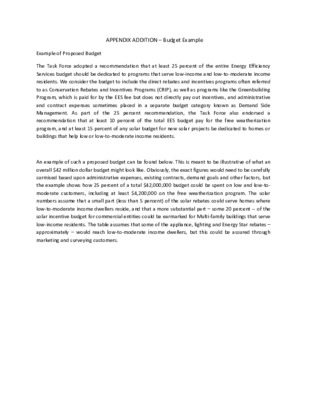Item 3a-Example of Budget_Cyrus Reed — original pdf
Backup

APPENDIX ADDITION – Budget Example Example of Proposed Budget The Task Force adopted a recommendation that at least 25 percent of the entire Energy Efficiency Services budget should be dedicated to programs that serve low-income and low-to-moderate income residents. We consider the budget to include the direct rebates and incentives programs often referred to as Conservation Rebates and Incentives Programs (CRIP), as well as programs like the Greenbuilding Program, which is paid for by the EES fee but does not directly pay out incentives, and administrative and contract expenses sometimes placed in a separate budget category known as Demand Side Management. As part of the 25 percent recommendation, the Task Force also endorsed a recommendation that at least 10 percent of the total EES budget pay for the free weatherization program, and at least 15 percent of any solar budget for new solar projects be dedicated to homes or buildings that help low or low-to-moderate income residents. An example of such a proposed budget can be found below. This is meant to be illustrative of what an overall $42 million dollar budget might look like. Obviously, the exact figures would need to be carefully surmised based upon administrative expenses, existing contracts, demand goals and other factors, but the example shows how 25 percent of a total $42,000,000 budget could be spent on low and low-to-moderate customers, including at least $4,200,000 on the free weatherization program. The solar numbers assume that a small part (less than 5 percent) of the solar rebates could serve homes where low-to-moderate income dwellers reside, and that a more substantial part – some 20 percent -- of the solar incentive budget for commercial entities could be earmarked for Multi-family buildings that serve low-income residents. The table assumes that some of the appliance, lighting and Energy Star rebates – approximately – would reach low-to-moderate income dwellers, but this could be assured through marketing and surveying customers. Category Amount Serving Low-Income Customers Amount Serving Low to Low-Moderate Income Customers Other Customers Total Weatherization $4,200,000 $0 $0 $4,200,000 Multi-Family EES $2,100,000 $2,100,000 $4,200,000 Loan Program Expenses $500,000 $500,000 $1,000,000 Solar Home Rebates $200,000 $5,000,000 $5,200,000 Solar Commercial Rebates $400,000 $1,200,000 $1,600,000 Green-Building Ratings and Codes $500,000 $2,500,000 $3,000,000 Emergency Air-Conditioning Program $200,000 $200,000 $400,000 Commercial Rebates and Incentives (not including Multi-Family) $4,500,000 $4,500,000 Demand Response $300,000 $1,600,000 $1,900,000 Thermal Storage $800,000 $800,000 Category Amount Serving Low-Income Customers Amount Serving Low to Low-Moderate Income Customers Other Customers Total Home Performance Energy Star $200,000 $2,300,000 $2,500,000 Appliance Efficiency, including AC, Refrigerators, etc $200,000 $800,000 $1,000,000 Energy Audits for Low-to-Moderate $200,000 $200,000 Lighting Rebates $200,000 $700,000 $900,000 Electric Vehicle Incentives $400,000 $400,000 Administration of all programs, including advertising, technical support, municipal support, program management etc. $500,000 $600,000 $9,100,000 $10,200,000 Total $4,900,000 $5,600,000 $31,500,000 $42,000,000